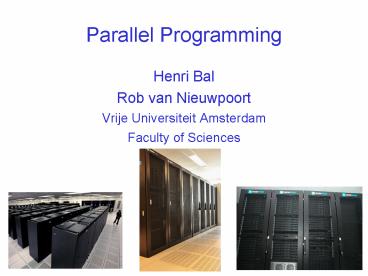Parallel Programming - PowerPoint PPT Presentation
Title:
Parallel Programming
Description:
Title: The IC Wall Collaboration between Computer science + Physics Author: bal Last modified by: bal Document presentation format: Custom Other titles – PowerPoint PPT presentation
Number of Views:105
Avg rating:3.0/5.0
Title: Parallel Programming
1
Parallel Programming
- Henri Bal
- Rob van Nieuwpoort
- Vrije Universiteit Amsterdam
- Faculty of Sciences
2
Overview
- What is parallel programming?
- Why do we need parallel programming?
- Organization of this course
- Practicum Parallel Programming
3
Parallel Programming
- Sequential programming
- Single thread of control
- Parallel programming
- Multiple threads of control
- Why parallel programming?
- Eases programming? Not really.
- Performance? Yes!
4
Famous quote
- Parallel programming may do something to revive
the pioneering spirit in programming,which seems
to be degenerating intoa rather dull and routine
occupation - S. Gill, Computer Journal, 1958
5
Why do we need parallel processing?
- Many applications need much faster machines
- Sequential machines are reaching their speed
limits - Memory becomes a bottleneck
- DRAM access times improve only 10 per year
- Caches more and more important
6
Moores law (1975)
- Circuit complexity doubles every 18 months
- Exponential transistor growth, resulting in
exponential growth of processor speeds - Weve now hit a power wall, halting speed
increases - Transistor growth now is used for multicore
CPUs,i.e. parallel machines!
7
Parallel processing
- Use multiple processors to solve large problems
fast - Also increases cache memory aggregate memory
bandwidth - Also called High Performance Computing (HPC)
- Multicore CPUs bring parallel processing to the
desktop - Can use many (inexpensive) multicore machines to
build very large parallel systems - Very cheap Graphics Processing Units (GPUs) also
contain many simple cores and can be used for
many parallel applications
8
History
- 1950s first ideas (see Gills quote)
- 1967 first parallel computer (ILLIAC IV)
- 1970s programming methods, experimental machines
- 1980s parallel languages (SR, Linda, Orca),
commercial supercomputers - 1990s software standardization (MPI), clusters,
large-scale machines (Blue Gene) - 2000s grid computing combining resources
world-wide (Globus) - Now multicores, GPUs, Cloud computing
9
Large-scale parallel machines
- Many parallel machines exist
- See http//www.top500.org
- Current 1 BlueGene/Q, 1572864 cores
- Many machines use GPUs
10
Our DAS-4 cluster
11
Challenging Applications
- Modeling ozone layer, climate, ocean
- Quantum chemistry
- Protein folding
- General computational science
- Aircraft modeling
- Handling use volumes of data from scientific
instruments - Lofar (astronomy)
- LHC (CERN, high-energy physics)
- Computer chess
- Analyzing multimedia content
- Generating movies
12
Pixars Up (2009)
Whole movie (96 minutes) would take 94 years on 1
PC (4 frames per day 1 second takes 6 days 1
minute per year)
13
Application areas
- Engineering and design
- Scientific applications
- Commercial applications (transactions, databases)
- Embedded systems (e.g., cars)
- This class focuses on scientific applications
14
About this Course
- Goal Study how to write programs that run in
parallel on a large number of machines. - Focus on programming methods, languages,
applications - Focus on distributed-memory (message passing)
machines and new machines (GPUs) - Prerequisites
- Some knowledge about sequential languages
- Little knowledge about networking and operating
systems - Concurrency Multithreading useful but not
required
15
Aspects of Parallel Computing
- Algorithms and applications
- Programming methods, languages, and environments
- Parallel machines and architectures
16
Course Outline
- Introduction in algorithms and applications
- Parallel machines and architectures
- Overview of parallel machines, trends in
top-500, clusters, many-cores - Programming methods, languages, and environments
- Message passing (SR, MPI, Java)
- Higher-level language HPF
- Applications
- N-body problems, search algorithms
- Many-core (GPU) programming (Rob van
Nieuwpoort)
17
Course Information
- Examination
- Written exam based on
- - Reader available electronically from
Blackboard - - Lectures
- More information (and slides example exam)
- http//www.cs.vu.nl/bal/parallel-programming.htm
l
18
Practicum Parallel Programming
- Separate practicum (6 ECTS)
- Implement algorithms in C/MPI and Java/Ibis
- Implement GPU algorithms
- Test and measure the programs on our DAS cluster
19
More information
- Register by email (see website)
- Starts after this course
- See http//www.cs.vu.nl/ppp






























